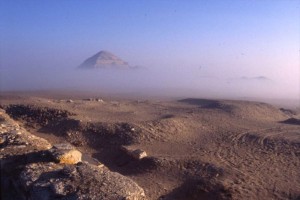 At the end of the 26th dynasty, a wholly new cemetery was established on previously virgin ground, about 200 meters to the southsouthwest of the pyramid of Neferre. It consists of large and smaller shaft tombs. According to the results of surface and geophysical survey, it contains 5-6 large and several smaller tombs, arranged into two rows leading approximately west to east. Of the large structures, the tombs of Udjahorresnet and Iufaa have been explored, and the exploration of the tomb of Menekhibneko was commenced recently. Of the smaller tombs, only that of Padihor and the anonymous tomb labeled R3 were excavated.
At the end of the 26th dynasty, a wholly new cemetery was established on previously virgin ground, about 200 meters to the southsouthwest of the pyramid of Neferre. It consists of large and smaller shaft tombs. According to the results of surface and geophysical survey, it contains 5-6 large and several smaller tombs, arranged into two rows leading approximately west to east. Of the large structures, the tombs of Udjahorresnet and Iufaa have been explored, and the exploration of the tomb of Menekhibneko was commenced recently. Of the smaller tombs, only that of Padihor and the anonymous tomb labeled R3 were excavated.
The entire group of these tombs is located on a small hill, from which long, gentle valleys descend to the east (to the area of the valley temple of Niuserre) and southeast (to north Saqqara), from where probably also the main access way led. According to our present knowledge it would seem that the entire group of larger and smaller tombs was constructed at the very end of the 26th dynasty, according to the graffiti found in the tomb of Udjahoresnet, its construction begun in the 41st or 42nd year of reign of Amasis, i.e. in the year 529 or 528 BC. It is likely that their construction ceased in the year 525 BC, when the Persian King Kambyses invaded Egypt and when the situation in Egypt remained unstable for several subsequent years. Actually, neither the tomb of Udjahorresnet, nor that of Iufaa have been completely finished. Some of the tombs were, hovever, used only afret this time, in the time of the reign o Dareios I.
In the vicinity of the large tombs, several simple burial were hitherto found. The bodies, belonging probably to the poor inhabitants of the neigbouring villages, were placed into shallow pits in the sand. Some of these poor burials may come from as late as the Ptolemaic period (200 – 300 years after the construction of large shaft tombs), and perhaps represent evidence of the esteem, in which the dignitaries buried in this part of the necropolis, and above all Udjahorresnet, were held by subsequent generations.
Cf. also:
• L. Bareš, „The Saite-Persian Cemetery at Abusir“, in: J.-Cl. Goyon (ed.), Proceedings of the Ninth International Congress of Egyptologists, Grenoble, September 6-12, 2004, (in press)
• L. Bareš, „Abusir in the First Millenium B.C.E.“, Annales du Service des Antiquités de l´Égypte (Volume in Honour of Aly Radwan), Cairo (in press)